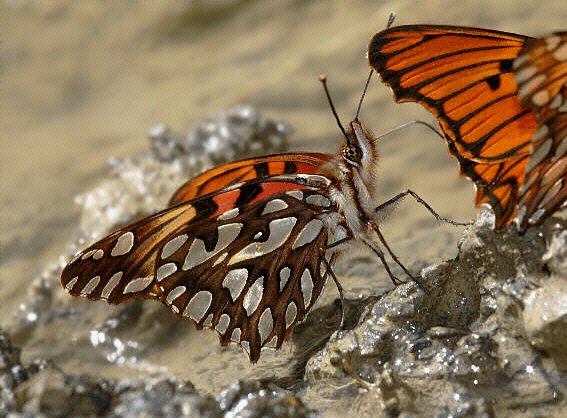
Introduction
The Heliconiinae was until a few years ago recently considered to be a full family equal in rank to the Nymphalidae, Satyridae, Papilionidae etc. In 1958 Erlich proposed that the families containing butterflies with only two pairs of legs should all be classified as subfamilies within the Nymphalidae. This proposition was again advanced by Ackery in 1984 and has since become accepted by most biologists. Thus we now have the Libytheinae, Satyrinae, Nymphalinae, Limenitidinae, Charaxinae, Apaturinae, Morphinae, Biblidinae, Ithomiinae, Danainae and Heliconiinae.
The higher classification of the Heliconiinae was revised by Penz & Peggie in 2003, being subdivided into the Acraeini, Argynnini and Heliconiini. The latter are colloquially known as Longwings and are characterised by their simple patterns, elongated forewings and delicate fluttering flight.
The Heliconiini includes the genus Heliconius (39 spp), and the smaller genera Dryas, Dryadula, Eueides, Neruda, Laparus, Philaethria, Podotricha, Agraulis and Dione. The latter genus contains 3 species – glycera, juno and moneta – all with orange uppersides and silver-spangled undersides.
Dione moneta is the most widespread species in the genus, occurring from the southern USA to Peru, Bolivia and northern Argentina.
Habitats
This species is migratory in behaviour so can be found in almost any habitat, and at any altitude from 0-3500m. It is most often encountered in open sunny areas including riverbanks, rocky slopes, pastures and roadsides – in fact anywhere where there is an abundance of nectar sources.
Lifecycle
The egg is yellow when first laid, but later turns reddish. It is laid either singly on the leaves and tendrils of Passiflora or Tetrastylis (Passifloraceae).
The larva when fully grown is dark brown, covered with grey and orange spots, and adorned with short whorled spines on the back and sides.
The chrysalis is dark brown with a rough texture. It is contorted in shape, with the wing-cases bowed forward, the thorax keeled, and a large notch between the thorax and abdomen. It is suspended by the cremaster from woody stems or dead leaves.
Adult behaviour
Males can sometimes be seen congregating in two’s or three’s at places where mountain rivulets ford roads, and filter-feed, drinking large quantities of clear water, unlike other Nymphalids, which tend to prefer imbibing from mud or damp sand. Both sexes nectar at a wide variety of flowers.
